Saturday, December 30, 2023
Do you know how to hang a painting? It’s okay if you don’t – I see paintings that have been damaged or are on the verge of falling off of their hanging hardware all the time. Here’s an art conservator’s guide for hanging paintings.
In my role as an art conservator, I frequently encounter paintings in my lab that have suffered damage because someone did not know how to hang a painting. Even when I’m doing my home-consultations, I too-often see paintings that are about to fall off their hooks or whose wires are about the fray apart. Knowing how to properly hang paintings is critical in preserving the artwork. Whether you’re a seasoned art enthusiast or a new collector, understanding the best practices behind displaying and safeguarding your paintings is crucial for their long-term well-being.
Post-Holiday Considerations:
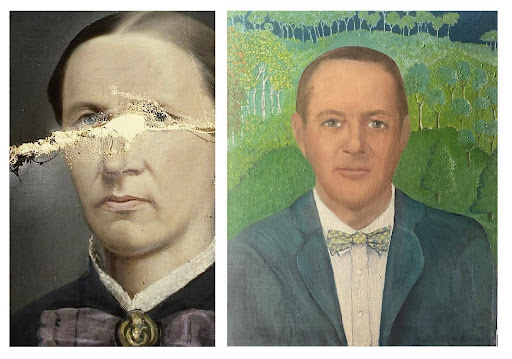
two family heirloom portraits are pictured. The one on the left depicting a Victorian woman has flaking running across the sitter’s face. The portrait of a man on the right needs to be cleaned of grime and other signs of weathering.
Given the holiday season, many individuals receive paintings as heartfelt gifts. If you find yourself with new acquisitions, follow these guidelines promptly to learn how to hang a painting and integrate your artwork seamlessly into your collection, maintaining their longevity.
- Hanging Considerations:
When it comes to hanging paintings, it’s essential to prioritize the safety of the artwork. Avoid hanging pieces in direct sunlight or areas with extreme temperature and humidity fluctuations, as these can lead to fading, warping, and cracking. Choose a location away from vents, fireplaces, or other sources of heat, as sudden temperature changes can adversely affect the paint and canvas.
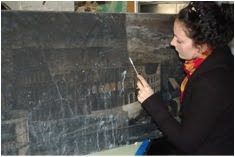
The smoke damage on this painting is a result of incorrect placement above a fireplace. It is important to know where and how to hang a painting to avoid this type of damage.
- Mounting and Framing:
Selecting the right frame and matting materials is a critical aspect of proper hanging. Opt for acid-free, archival materials to prevent chemical reactions that could harm the artwork over time. Ensure that the frame adequately supports the weight of the painting and that whoever assists you knows how to hang a painting.
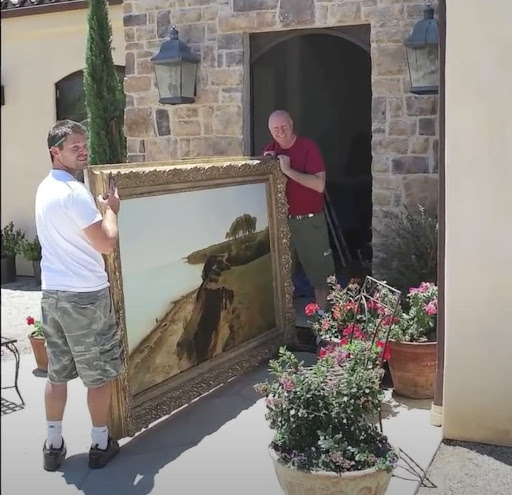
It is important to choose a frame that fits snugly that can support your painting’s weight
- Hanging Hardware:
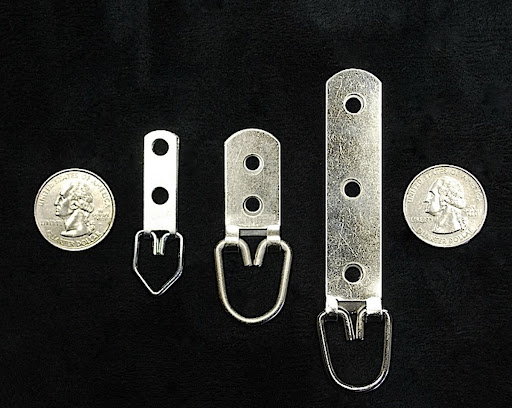
Quality wire attachment hardware for framed items
Invest in high-quality hanging hardware designed for the weight and size of your painting. Use D-rings and sturdy picture wire for a secure and evenly distributed support system. Check the hardware periodically to ensure it remains in good condition, preventing accidental falls and damage. For more info about hanging hardware, click here!
- Proper Spacing:
Allow sufficient spacing between paintings to prevent accidental collisions and promote proper air circulation. This helps maintain consistent environmental conditions around each artwork, reducing the risk of mold growth and other environmental damage.
- Storage Guidelines:
For paintings not currently on display, proper storage is equally crucial. Choose a dark, climate-controlled space with controlled temperature and humidity levels. Avoid storing paintings in basements, attics, or garages, as these areas are susceptible to temperature extremes and fluctuations. Here’s a guide for choosing the right storage facility for your artwork.
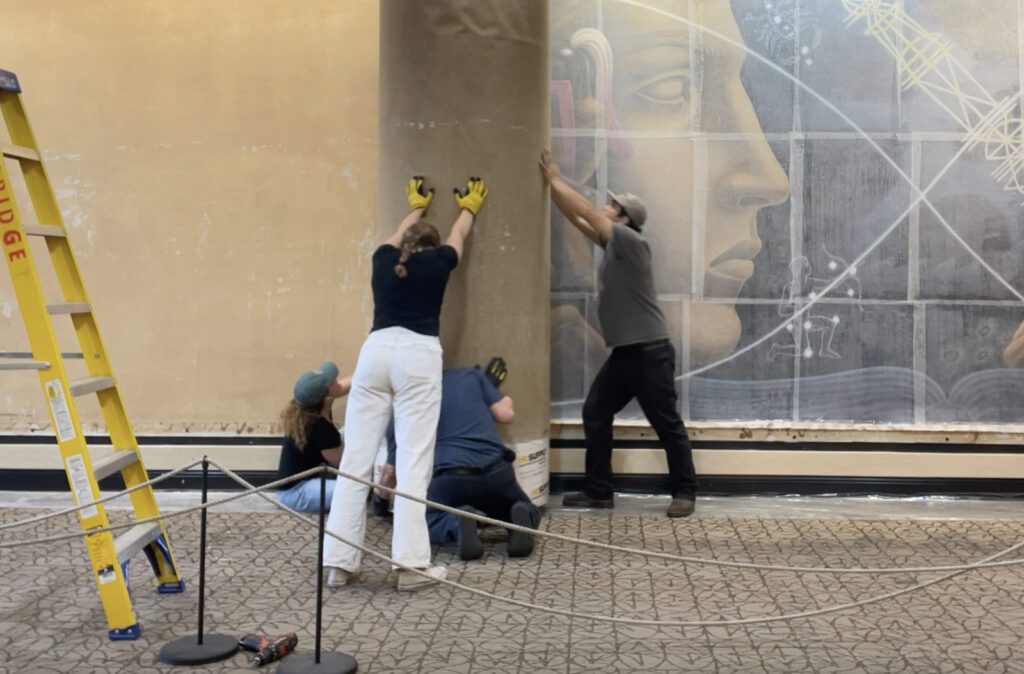
Removal of two 30ft murals from a medical center in Austin Texas. Our Professional Art Conservation Team moves every piece carefully and securely
- Protective Coverings:
When not displayed, consider covering paintings with archival materials such as acid-free paper or polypropylene plastic bags. This protects against dust, dirt, and potential scratches while allowing the artwork to “breathe” and avoid condensation.
- Handling Precautions:
When handling paintings, ensure your hands are clean and dry. Use gloves made of nitrile to prevent oils and dirt from transferring to the artwork. Support the painting from underneath, avoiding putting pressure on the canvas or paint surface.
- Rotation Practices:
If you have a substantial art collection, consider periodically rotating the displayed pieces with stored ones. This prevents prolonged exposure to light and environmental conditions, ensuring all artworks receive equal care and conservation attention.
The proper hanging and storage of paintings go beyond aesthetics – they are essential practices for preserving the artistic and monetary value of your collection. You’ll know how to hang a painting by adhering to these archival principles, you contribute to the longevity and beauty of the art you hold dear, allowing future generations to appreciate the same brilliance you see today.
For more information about Fine Art Conservation Laboratories’ art conservation services, please visit our website. If you’re in need of Las Vegas-based art conservation services, please feel free to visit our branch site here.
Has your artwork already suffered damage?
FACL is here to help you make that insurance claim.
Fine Art Conservation Laboratories’ 45 years of expertise in preserving and restoring art offers invaluable help and practical knowledge for helping people through the insurance claim process for damaged collectibles and art pieces. Our experienced team understands the complexities of insurance claims related to art, heirlooms, and antiques, providing reports that are properly prepared with information that the insurance company never puts in doubt. Fine Art Conservation Laboratories charges flat fees for this work, not a percentage of the claim settlement, and our expertise is honored nationwide. Let us help make the art, heirloom, and collectible part of the insurance claim process as seamless as possible and preserve your peace of mind.
This blog post has been syndicated at ExpertClick.com.
What does it mean that this article is “ syndicated”?
It’s a bit of a coup to get an article syndicated, and its certainly prestigious, as additional “proof” that the info and the author are considered far and wide authoritative and an expert in the field. So, enjoy and trust our content!! This article was syndicated for USA national redistribution.
When something is published, usually by a news source, and is made available through different venues for redistribution then it is said to be syndicated. Publications that are syndicated are usually considered of value as being from an expert, educational, new worthy or valuable for wide popular interest. See syndication page at the renowned publicity site: https://www.expertclick.com/NRWire/
This website’s syndication included:
1) Included in the ExpertClick Press Room as a ‘press release.’ (different than a ‘news release’)
2) Included in the ‘Speaker Bureau Platform Page.’
3) Shown on the front page of ExpertClick, in rotation with other most recent posts.
4) Shown in the ‘News Release Results page.’
5) Included on optimized for searches on all my topics of expertise.
6) Shown via RSS linked from the Press Room. (A specific way news is actively distributed within the industry)
7) Shown in the full RSS feed from ExpertClick. (Another, different specific way news is actively distributed within the industry)
8) Syndicated to LexisNexis.com As of 2006, the company had the world’s largest electronic database for legal and public-records related information, distributor of academic content and expert opinion.
This article has been syndicated at https://www.expertclick.com/NRWire/